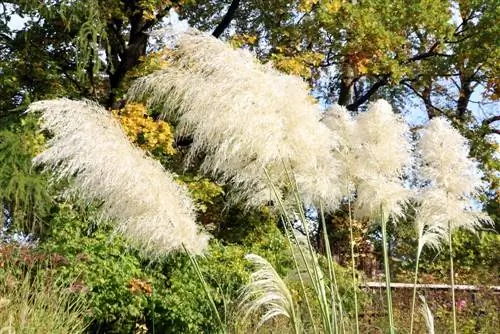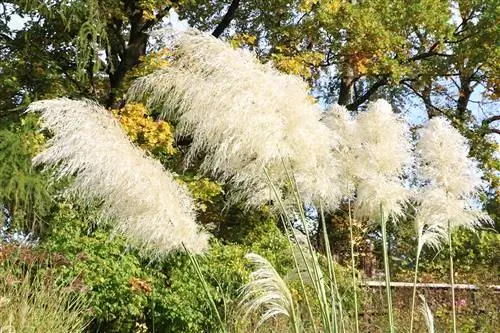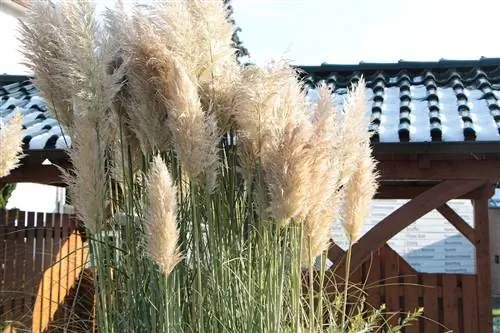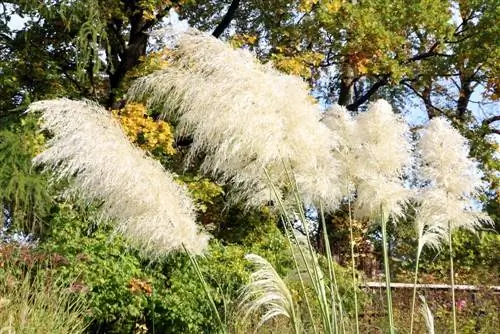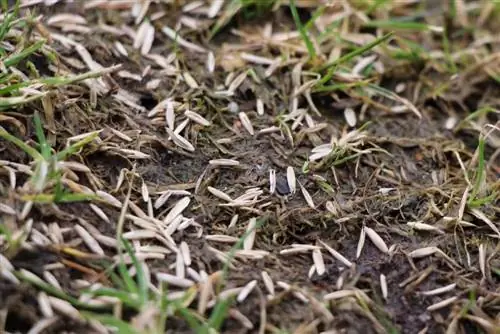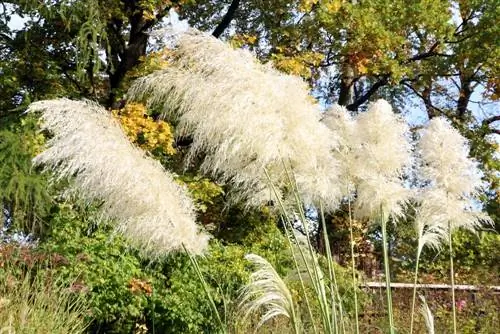- Author admin [email protected].
- Public 2023-12-17 03:39.
- Last modified 2025-01-24 12:45.
The pampas grass is very decorative thanks to its large fronds. This ornamental grass comes in many different varieties that grow to different heights and produce white, pink or somewhat silvery fronds. The fronds form between July and October and last a very long time. Autumn is therefore the time when the pampas grass comes into its own.
Pampas grass location
The pampas grass should best stand alone and be given enough space, because its leaves are slightly overhanging and the fronds grow up to two and a half meters high. Several plants in a row therefore require a distance of at least one meter. Pampas grass prefers a sunny to partially shaded location in the garden. There it should be protected from too much wind and, above all, from too much moisture. So that waterlogging does not occur, which quickly leads to rotting of the root ball, the soil is loosened well before planting.
A drainage layer of gravel at the bottom of the planting hole provides additional protection against waterlogging. Pampas grass is also very suitable as a pot plant for the terrace. Then it needs a bucket with a volume of around 40 liters so that it stands securely and has enough space for its root growth.
Care in summer
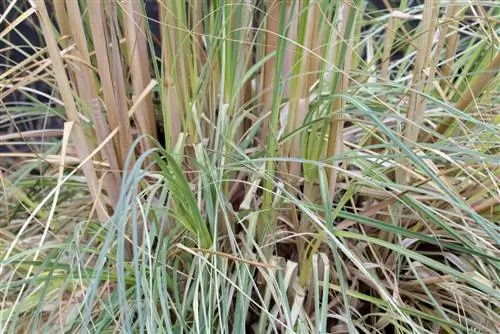
During the summer, you should pay attention to good watering, because the pampas grass evaporates a lot of water through its long leaves. Fertilization takes place from spring to autumn. If fronds do not form in the first year of a newly planted specimen, there is no reason to worry, as it may well be that the pampas grass will only bloom in the second or third year.
Care in winter
Pampas grass is native to the southern part of South America. The winters there are cold, but dry. The plant therefore suffers more from snow and rain than from frost. A winter location under a roof is therefore particularly recommended for potted plants, but they can also overwinter in a cold room. If there is no suitable space, the pot should be wrapped with bubble wrap or fleece to protect the pot ball from frost. As a container plant, pampas grass needs water even in winter so that the pot ball does not dry out completely and therefore needs to be watered every now and then.
- Planted specimens are best tied together loosely in winter to protect them a little from moisture.
- Alternatively, mats that are placed around the plant or a fleece that covers the entire plant are also suitable.
- In addition, the ground can be covered with leaves or brushwood.
- Winter protection is particularly recommended in locations where it often snows in winter.
Cutting pampas grass
Pampas grass should always be pruned in spring, as water could penetrate through the hollow stalks and damage the plant. The long leaves also protect the root area from frost and moisture in the cold season. The pampas grass is therefore only shortened to 10 to 15 centimeters above the ground after winter. A good time for this is March and April. Pampas grass only sprouts relatively late, so after a long winter it can happen that new growth doesn't begin until May.
Dangers to pampas grass
The decorative and popular pampas grass also has enemies and many diseases can be dangerous for this beautiful plant. Especially in the cold winter months, there is a risk of rot quickly due to prolonged moisture. Here the moisture draws into the interior of the perennial and cannot find a way out, so that the pampas grass begins to mold, which can completely destroy the plant. For this reason, it is advisable to tie up the pampas grass in winter and spread enough leaves on the ground. This absorbs liquid so that the plant does not get too wet so easily.
Propagate or rejuvenate pampas grass
If you want to multiply or rejuvenate your pampas grass, you can do this through so-called division. Here it is advisable to saw through the root balls with a pruning saw or to cut them off with a spade. The offshoot is then replanted in another location and lightly fertilized. It is important to only use fresh pampas grass, as this can handle transplanting better. After many years, the old pampas grass often becomes dry from the inside and dies. In this situation, it is particularly important to completely remove the old and dry pampas grass so that the plant can rejuvenate without any problems and the younger grass is not attacked.
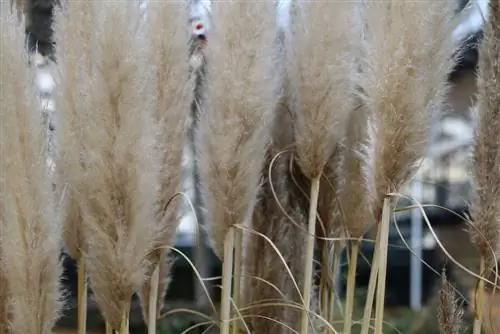
The old and dry grasses are usually located inside, where new pampas grass will of course grow next year. The best time to carry out propagation or rejuvenation is late spring, because then the plant has fully recovered from the strenuous winter. Of course, interested parties can also sow new seeds, but this again involves a lot of work. If propagation is carried out by separating side shoots, you can be sure that a plant is created that is identical to the mother plant.
All important data about pampas grass at a glance:
- Location: sunny or partially shaded and ideally alone
- protect from too much moisture and wind
- tie together in winter and cover with leaves
- cut in spring and remove the hollow grass
- shorten to 10-15 cm above the ground
- pay particular attention to waterlogging and rot in winter
- Propagation by cutting off and replanting a side shoot
- Carry out rejuvenation in spring and completely remove old, dry blades of grass

